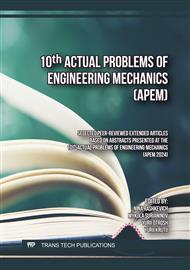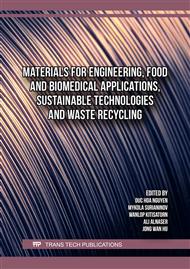[1]
M.A. Foyouzat, M. Mofid, An analytical solution for bending of axisymmetric circular/annular plates resting on a variable elastic foundation. European Journal of Mechanics - A/Solids, 74 (2019) 462–470
DOI: 10.1016/j.euromechsol.2019.01.006
Google Scholar
[2]
M.H. Surianinov, Y.S. Krutii, А.S. Karnaukhova, О.M. Klymenko, Analytical method for calculating annular plates on a variable elastic foundation. Modern Construction and Architecture, (2) (2022) 37–43
DOI: 10.31650/2786-6696-2022-2-37-43
Google Scholar
[3]
M. Surianinov, Y. Krutii, D. Kirichenko, O. Klimenko, Calculation of annular plates on an elastic foundation with a variable bedding factor. Mechanics and Mathematical Methods, 4(2) (2022) 43–52
DOI: 10.31650/2618-0650-2022-4-2-43-52
Google Scholar
[4]
M. Surianinov, Y. Krutii, O. Klymenko, V. Vakulenko, S. Rudakov, Axisymmetric bending of circular plates on a variable elastic foundation. International scientific applied conference "Problems of emergency situations" (с. 3–10). Trans Tech Publications, 2023. Ltd
DOI: 10.4028/p-L9yr2n
Google Scholar
[5]
A. Karasin, A finite grid solution for circular plates on elastic foundations / Abdulhalim Karasin, Polat Gülkan, Gultekin Aktas // KSCE Journal of Civil Eng. 19(4) (2014) 1157‒1163
DOI: 10.1007/s12205-014-0713-x
Google Scholar
[6]
A.W. Crook A transfer matrix method for calculating the elastic behaviour of annular plates. The Journal of Strain Analysis for Engineering Design, 26(1) (1991) 65‒73
DOI: 10.1243/03093247V261065
Google Scholar
[7]
J. Vaskova, P. Matečková, Software for Design and Assessment of Rotationally Symmetrically Loaded Reinforced Concrete Slabs in the Shape of Circle or Ring. In Applied Mechanics and Materials. Trans Tech Publications, 749 (2015) 368–372 Ltd
DOI: 10.4028/www.scientific.net/amm.749.368
Google Scholar
[8]
F. Vivio, V. Vullo, Closed form solutions of axisymmetric bending of circular plates having non-linear variable thickness. International Journal of Mechanical Sciences, 52(9) (2010) 1234–1252
DOI: 10.1016/j.ijmecsci.2010.05.011
Google Scholar
[9]
A. Behravan Rad, Semi-Analytical solution for functionally graded solid circular and annular plates resting on elastic foundations subjected to axisymmetric transverse loading. Advances in Applied Mathematics and Mechanics, 4(2) (2012) 205–222
DOI: 10.4208/aamm.10-m11104
Google Scholar
[10]
A. Behravan Rad, A. Alibeigloo, Semi-Analytical solution for the static analysis of 2D functionally graded solid and annular circular plates resting on elastic foundation. Mechanics of Advanced Materials and Structures, 20(7) (2013) 515–528
DOI: 10.1080/15376494.2011.634088
Google Scholar
[11]
Y.S. Krutii, M.G. Sur'yaninov, G.S. Karnaukhova, Calculation method for axisymmetric bending of circular and annular plates on a changeable elastic bed. Part 1. Analytical relations. Strength of Materials, 53(2) (2021) 247–257.
DOI: 10.1007/s11223-021-00282-2
Google Scholar



